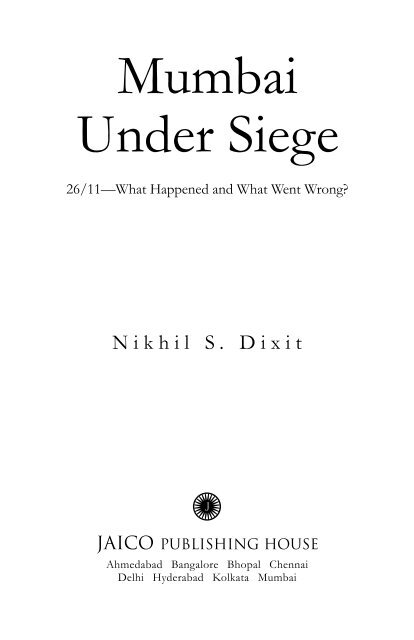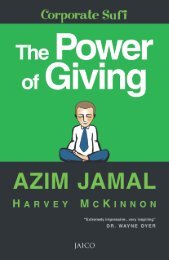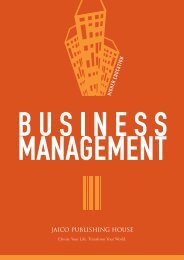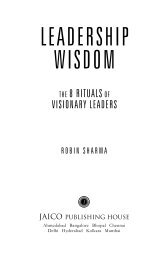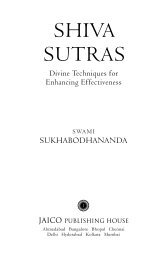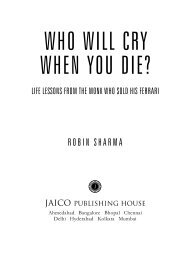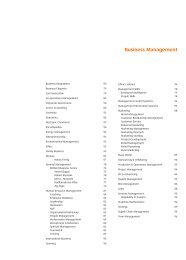Mumbai Under Siege - Jaico Publishing House
Mumbai Under Siege - Jaico Publishing House
Mumbai Under Siege - Jaico Publishing House
You also want an ePaper? Increase the reach of your titles
YUMPU automatically turns print PDFs into web optimized ePapers that Google loves.
<strong>Mumbai</strong><br />
<strong>Under</strong> <strong>Siege</strong><br />
26/11—What Happened and What Went Wrong?<br />
N i k h i l S . D i x i t<br />
JAICO PUBLISHING HOUSE<br />
Ahmedabad Bangalore Bhopal Chennai<br />
Delhi Hyderabad Kolkata <strong>Mumbai</strong>
Published by <strong>Jaico</strong> <strong>Publishing</strong> <strong>House</strong><br />
A-2 Jash Chambers, 7-A Sir Phirozshah Mehta Road<br />
Fort, <strong>Mumbai</strong> - 400 001<br />
jaicopub@jaicobooks.com<br />
www.jaicobooks.com<br />
© Nikhil S. Dixit<br />
MUMBAI UNDER SIEGE<br />
ISBN 978-81-7992-995-7<br />
First <strong>Jaico</strong> Impression: 2009<br />
No part of this book may be reproduced or utilized in<br />
any form or by any means, electronic or<br />
mechanical including photocopying, recording or by any<br />
information storage and retrieval system,<br />
without permission in writing from the publishers.<br />
Printed by<br />
Rashmi Graphics<br />
#3, Amrutwel CHS Ltd., C.S. #50/74<br />
Ganesh Galli, Lalbaug, <strong>Mumbai</strong>-400 012<br />
E-mail: tiwarijp@vsnl.net
Dedication<br />
This book is dedicated to the brave men of the <strong>Mumbai</strong><br />
police force and the NSG, who laid down their lives while<br />
fighting the fidayeens, and the innocent victims of the<br />
November 26, 2008 terror attacks in <strong>Mumbai</strong>.
Acknowledgments<br />
This book could not have been completed without the<br />
help of many of my friends, some of whom are<br />
policemen.<br />
I would also wish to thank:<br />
My executive editor, R Jagannathan, who was kind enough<br />
to grant me permission to go ahead with the book.<br />
My boss, B Mahesh, who was extremely supportive of my<br />
endeavour and encouraged me to complete this task.<br />
My present employer, DNA, for being patient with me and<br />
allowing me to devote my time and energy on writing this<br />
book.<br />
I am greatly indebted to senior journalist and my<br />
professor, Mr Abhay Mokashi, who has been, and always<br />
will be, my inspiration.<br />
Expressing any amount of gratitude will be too little when
vi <strong>Mumbai</strong> <strong>Under</strong> <strong>Siege</strong><br />
it comes to thanking my wife Sweta, a far better journalist<br />
and writer than me, who not only inspired me to write<br />
this book, but also helped me complete it. She had to bear<br />
all the long hours that I spent in front of the computer<br />
and all the mess in the house with reports strewn<br />
everywhere. I thank her for being patient and understanding.<br />
I also wish to thank my parents for supporting and<br />
encouraging me to go ahead with this book.<br />
A special thanks to J Dey and Dev Chatterjee. Without<br />
their support this book would have not been possible.<br />
Many thanks to Ayaz Memon, Sanjay Vhanmane,<br />
Prabhakar Pawar, Calvin Joshua, Neelesh Dixit, Gautam<br />
Ramanujan, Dhiraj Gopalani, S P Nauriyal, and Leslie<br />
Pereira who gave me the help I needed to complete this<br />
book.
Prologue<br />
Lest We Forget<br />
<strong>Mumbai</strong> will perhaps never forget the night of November<br />
26, 2008. It took only a few minutes for this city, known<br />
for its never-say-die attitude and a vibrant nightlife, to turn<br />
into the city of Death.<br />
Making their way to <strong>Mumbai</strong> from Karachi in Pakistan,<br />
ten fidayeens used the cover of darkness to sneak into the<br />
city and mercilessly kill 165 innocents, including a top cop<br />
from the anti-terror cell of the <strong>Mumbai</strong> police. This<br />
terrible incident not only exposed various chinks in the<br />
Indian security system, but also showed how uncaring<br />
authorities are about the lives of common people.<br />
This was not the first time that the city was ravaged so<br />
brutally. Just two years ago, in 2006, a series of bomb<br />
blasts ripped apart the lifeline of <strong>Mumbai</strong> – the local trains<br />
– killing more than 174 people who were making their way<br />
home after work.
viii <strong>Mumbai</strong> <strong>Under</strong> <strong>Siege</strong><br />
No lessons were learnt either from 2006 or from any other<br />
terror attack on the city and in other parts of the country.<br />
One feels that there would perhaps be no takeaways from<br />
the 26/11 attack as well. <strong>Mumbai</strong> is the most<br />
cosmopolitan city in India with its people welcoming<br />
migrants irrespective of their caste, creed, religion etc.<br />
Though there are a few politicians who try to sow the<br />
seeds of enmity based on language, and religion, most<br />
<strong>Mumbai</strong>kars prefer to mind their own business.<br />
<strong>Mumbai</strong> generates so much income in a year that it<br />
contributes to almost 40 per cent of the country’s tax kitty.<br />
No wonder then, the city is known as the financial capital<br />
of the country. The city is home to billionaires, slum<br />
dwellers, and millions belonging to the working class. Over<br />
six million people travel to work every day by trains, buses,<br />
and private transport. The standard of living for the<br />
majority is not very good, and yet they come to work with<br />
a smile every day.<br />
The Pakistan-based Lashkar-e-Toiba (LeT) fidayeens<br />
brought the city to its knees by attacking Leopold Café, a<br />
popular restaurant and bar frequented by western tourists;<br />
the most luxurious and expensive hotels – The Taj and<br />
Oberoi-Trident – regular haunts for the city’s glitterati and<br />
corporate bigwigs; and the Chhatrapati Shivaji Terminus<br />
(CST), a heritage structure and one of the most crowded<br />
and busiest railway stations in the world. They also killed<br />
a rabbi and his wife at Nariman <strong>House</strong>, home to a few<br />
members of the orthodox Jewish group, Chabad<br />
Lubavitch.
Prologue ix<br />
The fidayeens’ motive was to gain maximum publicity and<br />
maim the city’s spirit. However, within days, the Taj and<br />
Oberoi had re-opened for business. Ratan Tata, Chairman<br />
of the Taj Group of hotels said, “We can be hurt but we<br />
cannot be knocked down.” Mr Tata’s words summed up<br />
the sentiments of millions of <strong>Mumbai</strong>kars.<br />
What is most worrying is that after 9/11, Islamic<br />
fundamentalist groups led by Al Qaeda – unemployed<br />
after the Afghanistan war – joined hands with Kashmiri<br />
militants and found a common enemy in India. Since then,<br />
a series of bomb blasts across all major Indian cities has<br />
killed and maimed thousands. Such attacks have been<br />
increasing since 2008. In an attack in Ahmedabad, in the<br />
state of Gujarat, in July, 55 people were killed, in<br />
September, serial bomb blasts in Delhi (India’s capital) laid<br />
claim to 20 lives. <strong>Mumbai</strong> was probably just another<br />
destination in their terrible itinerary.<br />
The U.S. government never treated the fidayeen attacks in<br />
India the way they would have treated bombings in<br />
Madrid, Bali, or London. The Federal Bureau of<br />
Investigation (FBI) the U.S’s premier investigation agency<br />
always maintained that the problem in India was a local<br />
one or ‘homegrown’. They meant that local Muslim<br />
groups with help from Pakistan-based terror outfits were<br />
fighting the local population. They did not see it as part<br />
of America’s war on terror.<br />
The attacks in <strong>Mumbai</strong> have proved that theory wrong.<br />
<strong>Mumbai</strong> is now on the global terror map and it will be<br />
some time before a foreign national can feel safe while
x <strong>Mumbai</strong> <strong>Under</strong> <strong>Siege</strong><br />
sipping beer at popular tourist haunts such as Leopold<br />
Café.<br />
According to preliminary investigations by the <strong>Mumbai</strong><br />
police, the ten fidayeens began their journey on November<br />
23 from Karachi, in Pakistan, in a small fishing boat. The<br />
group then boarded a Pakistani vessel Al Husseni, and then<br />
hijacked an Indian trawler MV Kuber to cross the porous<br />
Indian border. The trawler mingled with thousands of<br />
other vessels sailing towards <strong>Mumbai</strong>. Surprisingly, an<br />
Indian Navy exercise was on at that time, in those very<br />
same waters, to detect infiltration.<br />
By the evening of November 26, the fidayeens had landed<br />
in <strong>Mumbai</strong> – slipping past hundreds of Indian Navy and<br />
Coast Guard ships. They then made their way to their<br />
predetermined destinations by taxi. After 60 hours of<br />
chaos and terror, nine fidayeens were killed by Indian<br />
security forces, and one, Mohammad Ajmal Amir alias<br />
Kasab, from Faridkot in Pakistan, was arrested.<br />
The Taj Mahal hotel, which was built by legendary<br />
industrialist Jamshetji Tata to avenge an insult by the<br />
British who would not let him enter a White-only hotel,<br />
was ravaged by a fire that could not be put out for hours.<br />
The fidayeens perhaps got what they wanted –international<br />
headlines – since media persons from across the world<br />
came to <strong>Mumbai</strong> to cover the horror.<br />
Inside the Oberoi-Trident Hotel, the fidayeens showed<br />
absolutely no mercy towards the victims. Eyewitnesses said<br />
that the gunmen had asked them to stand in a queue
Prologue xi<br />
waiting to be shot, while they spoke to someone on their<br />
mobile phones. Their handlers back in Pakistan wanted<br />
to hear the gunshots. The killers were laughing and joking,<br />
and when the victims asked them why they were doing<br />
this, the fidayeens reminded them of the atrocities<br />
committed during the Babri Masjid demolitions, Jammu<br />
and Kashmir and during the Gujarat riots. It was clear that<br />
the fidayeens, who looked like college kids in their early 20s,<br />
were obsessed with retribution for Hindu atrocities against<br />
Muslims.<br />
The Special Forces killed the last fidayeen in the Taj after a<br />
60-hour gun battle. By then scores of innocents had been<br />
killed and <strong>Mumbai</strong>’s pride was severely dented. This book<br />
highlights the stories of a few unsung heroes, the officers<br />
who laid their life down without a moment’s hesitation<br />
about their families back home.
Contents<br />
Acknowledgments v<br />
Prologue vii<br />
1. A Fidayeen Caught Alive 1<br />
2. The Plot 7<br />
3. A Dangerous Mind Reveals All 17<br />
(Ajmal’s confession in his own words)<br />
4. Terror Travels By Sea 25<br />
5. Leopold Café 29<br />
6. The Taj Mahal 33<br />
7. The Oberoi 45<br />
8. The Nariman <strong>House</strong> 53<br />
9. CST – Cama Hospital 61<br />
10. Karkare, Kamte & Salaskar Encounter 69
xiv <strong>Mumbai</strong> <strong>Under</strong> <strong>Siege</strong><br />
11. The <strong>Mumbai</strong> <strong>Siege</strong> Ends 81<br />
12. Survivor Stories 85<br />
13. What Went Wrong: Intelligence Failures 101<br />
14. Did The Fidayeens Botch Up The Actual Plan? 121<br />
15. The Plan And Strategies Made By Terror Outfits<br />
To Attack <strong>Mumbai</strong> 125<br />
16. Precautions 131<br />
17. Foreign Agencies 137<br />
18. Why <strong>Mumbai</strong>? 147<br />
19. Ill-Prepared <strong>Mumbai</strong> Police 153<br />
20. <strong>Mumbai</strong> Police: A Demoralised Force Cut A<br />
Sorry Figure 159<br />
21. Previous Attacks And The Legal Tangle 169<br />
22. Lessons Learnt 175
1<br />
A Fidayeen Caught Alive<br />
The perennially busy and noisy junction at Girgaum<br />
Chowpatty was eerily silent. The night was unusually<br />
quiet. The brightly lit road, which on any other day would<br />
be full of people crowding around food stalls, was empty<br />
as if it was haunted. Only the shadows of the heavily<br />
armed and nervous policemen could be seen.<br />
Residents of the buildings opposite Girgaum Chowpatty<br />
were not used to the deathly silence on the road below.<br />
With ‘breaking news’ of heavily armed terrorists creating<br />
havoc in the city, people were glued to their television sets,<br />
trying to get the latest on the mayhem.<br />
When it was clear that South <strong>Mumbai</strong> was the main target,<br />
jittery residents chose to remain indoors and catch the<br />
action live on television. An occasional car would tear<br />
through the road, it would be stopped by the police. Weary<br />
residents would peep through their windows while the<br />
police checked the car and told the driver that no one was<br />
allowed into South <strong>Mumbai</strong>.
2 <strong>Mumbai</strong> <strong>Under</strong> <strong>Siege</strong><br />
A few minutes after midnight, the police suddenly swung<br />
into action. Their walkie-talkies crackled to life and brief<br />
instructions were given. Police constables ran from one<br />
end of the road to the other trying to place enough heavy,<br />
rusted iron barricades to seal the road.<br />
The entire junction was turned into a fortress within<br />
minutes, making the residents even more anxious. “The<br />
gunmen have hijacked a silver-colour Skoda car and it is<br />
heading your way,” reported the voice on the walkie-talkie<br />
in Marathi. The barricades across the road ensured that<br />
not even a bicycle could pass through, an unusual sight,<br />
but given the situation, this probably was a very wise<br />
decision.<br />
The 20-odd policemen from the local D B Marg police<br />
station found themselves in a bizarre situation. They were<br />
trained to handle millions of people who throng the<br />
Girgaum Chowpatty every year for immersing Ganpati<br />
idols. They weren’t trained to handle terrorists on the run.<br />
The policemen armed with their archaic .303 rifles,<br />
revolvers, batons, and lathis placed themselves at strategic<br />
positions and waited with bated breath. Among them was<br />
48-year-old Assistant Sub-Inspector – Tukaram Omble –<br />
armed with a lathi and a wireless set. He would have<br />
passed off as any other tumbaku (tobacco) chewing police<br />
officer, but Omble was about to create history.<br />
Interestingly, Omble was that night standing at the very<br />
place where he had stood a few months ago to help people<br />
fight off jelly fishes that had floated ashore from the<br />
Arabian Sea.
A Fidayeen Caught Alive 3<br />
The silence was once again broken by the crackle of the<br />
walkie-talkie, the voice on the other side said that the<br />
Skoda had passed Marine Drive and would reach them at<br />
any moment. “It has to be stopped under any circumstance,”<br />
instructed the voice.<br />
The nervous policemen once again checked their positions<br />
and waited, as their sweaty palms gripped their guns.<br />
Their hearts started racing as sounds of a car approaching<br />
the junction at breakneck speed tore through the eerie<br />
silence. The well-lit road was now even brighter with the<br />
blazing headlights of the car zooming towards them.<br />
But it screeched to a halt about 50 meters in front of the<br />
barricades and the headlights were switched off. It was as<br />
if the people inside were contemplating their next move.<br />
To ensure that there were no innocent citizens in the car,<br />
a police officer spoke through a loudspeaker and told the<br />
occupants of the car to get out and start walking towards<br />
the police, with their hands in the air.<br />
But, no one moved. Those few moments of silence<br />
stretched towards eternity, while each side waited for the<br />
other to act first. Since no one got out of the car in spite<br />
of the warning, the policemen were now sure that this was<br />
the car they were warned about. Suddenly, the headlights<br />
blazed on, almost blinding the cops and the car instantly<br />
accelerated as if it were in an Formula One motor race.<br />
The car had almost reached maximum speed as it neared<br />
the barricades and before the policemen could react, it
4 <strong>Mumbai</strong> <strong>Under</strong> <strong>Siege</strong><br />
turned right, towards the divider, in an attempt to cross<br />
to the other side. But, the front wheel of the car got<br />
caught in the divider, taking the driver by surprise.<br />
Seizing the opportunity, the police team started firing at<br />
the car, but the driver (later identified as Ismail Khan)<br />
instantly responded with a shower of bullets from his<br />
sophisticated AK-47 assault rifle.<br />
Omble was standing at the other end of the road from<br />
where he had a clear view of the other occupant in the<br />
front seat. Maintaining his composure, Omble quickly<br />
took stock of the situation. He had seen that the other<br />
gunman was struggling to shoot from his AK-47 rifle.<br />
Seizing the opportunity, Omble leapt towards the gunman<br />
and reaching through the window, grabbed the rifle with<br />
one hand and tried to open the door with the other.<br />
The gunman had bullet injuries on both his hands. Ajmal<br />
was finding it difficult to hold on to the gun. As Omble<br />
tried to grab it, Ajmal pressed the trigger with his thumb<br />
and five bullets pierced Omble’s body.<br />
As his blood flowed away, Omble held on to the gun and<br />
grabbed it as he fell to the ground. But, still, the police<br />
constable had not eased the pressure on the gun. This<br />
forced the gunman out of the car and to his knees, giving<br />
the other policemen an opportunity to overpower the<br />
unarmed gunman, while Omble collapsed to the ground.<br />
Meanwhile, other policemen, including Sub-Inspectors<br />
Bhaskar Kadam, Sanjay Govilkar, and Assistant Police
A Fidayeen Caught Alive 5<br />
Inspector Hemant Bavdhankar were engaged in a gun<br />
battle with Ismail, which finally ended with the terrorists<br />
death.<br />
The entire incident was over in a few minutes, but in those<br />
few minutes, Omble had pulled off a feat unmatched<br />
anywhere in the world. He had caught a dreaded fidayeen<br />
(suicide bomber) – Mohammad Ajmal Amir alias Kasab<br />
– alive.<br />
Born to a farmer in Satara district of Maharashtra, Omble<br />
was the youngest of four children. He is survived by his<br />
wife and four daughters.<br />
His bravery helped the nation considerably, because Ajmal<br />
is alive and India and the world could find out who the<br />
perpetrators of the 26/11 terror attacks in <strong>Mumbai</strong> were.<br />
If Ajmal too had died, Indian security agencies would have<br />
been able only to speculate where the attackers had come<br />
from and who had planned it.<br />
The government of India has now honoured Omble with<br />
an Ashok Chakra (India’s highest awarded for gallantry<br />
away from the battlefield) for his exemplary courage and<br />
bravery.<br />
When the encounter at the Girgaum Chowpatty signal<br />
ended, the D B Marg police officers did not know that<br />
Omble had probably captured someone of international<br />
importance. As the police gathered around the injured<br />
Ajmal, the locals who had until then remained hidden in<br />
the bylanes, rushed out and started beating up Ajmal. The
6 <strong>Mumbai</strong> <strong>Under</strong> <strong>Siege</strong><br />
furious mob could have surely lynched Ajmal to death.<br />
Fortunately, wisdom prevailed and the police officers<br />
realised the importance of ensuring Ajmal’s safety.<br />
They immediately dispersed the crowd and put Ajmal into<br />
a police van and rushed him to the nearby Nair hospital.<br />
At the hospital, doctors, nurses and other hospital staff<br />
gathered around Ajmal to catch a glimpse of a fidayeen.<br />
They wondered how a young innocent-looking boy could<br />
kill so many innocent people, and still seem normal.<br />
In the hospital, Ajmal was sad that he had been captured<br />
alive. At first, he begged the doctors to kill him, and then<br />
he said that he wanted to live, but requested the authorities<br />
not to let the news out that he was captured alive. “My<br />
handlers in Pakistan will kill my family if they know that<br />
I have been captured alive,” Ajmal told a police officer.<br />
After the doctors treated him for his wounds, the police<br />
officers took over. Ajmal told them everything about<br />
himself and why and how he had become a fidayeen.


